Lucia Lee
Last update: 08/10/2025
“Since you bought this, you might also like…” or “Customers who viewed this item also purchased…” aren’t just random pop-ups you see when shopping online. They are personalized product recommendations that modern ecommerce businesses use strategically to nudge customers toward a purchase.
For customers, such recommendations create a highly enjoyable and intuitive shopping journey, and for ecommerce businesses like yours, they’re a proven driver of conversions, loyalty, and long-term growth. In this ultimate guide, we’ll explore what personalized product recommendations are, how they work, and how your store can use them to deliver smarter shopping experiences that turn browsers into buyers.
Personalized product recommendations are tailored suggestions presented to shoppers based on their unique shopping insights like user preferences, browsing history, purchase patterns, and interactions with your ecommerce store.
Think of it as the online equivalent of an in-store salesperson who remembers a customer’s tastes and guides them toward items they’ll love. Powered by advanced AI recommendation algorithms, these suggestions can range from showing similar items a visitor has browsed, to recommending complementary products that fit perfectly with a past purchase.
With the ecommerce market getting more crowded than ever before, generic product recommendations that feel irrelevant will not only get you nowhere but also frustrate customers. This is where personalized product recommendations come in, helping you stand out from competitors and win customers’ attention and trust. Let’s explore how you can turn product recommendations into a strategic advantage:
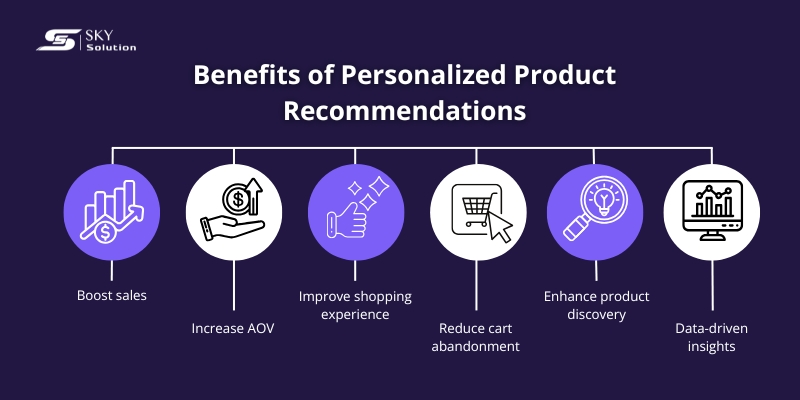
Benefits of personalized product recommendations
Boost sales with precise product targeting
When shoppers receive personalized offers that match their interests, they’re more likely to act. By providing personalized product recommendations, you help customers cut through the noise and turn browsing into buying seamlessly, increasing sales opportunities.
Also read: AI for Conversion Rate Optimization: A Guide for Businesses
Increase average order value (AOV)
The real power of personalized recommendations goes beyond nudging customers to buy - they can significantly boost your AOV. With automated upsells and cross-sells, you can seamlessly guide shoppers toward higher-value or complementary products, making each transaction more profitable.
Improve the individual shopping experience
A tailored journey makes customers feel understood and valued. By leveraging customer behavior analysis, you can deliver recommendations that create a smoother, more enjoyable individual shopping experience that drives retention and fosters long-term loyalty.
Reduce cart abandonment and enhance product discovery
Nothing drives shoppers away faster than irrelevant suggestions. That’s why personalized product recommendations have become a must-have for every ecommerce business. At the same time, intelligent recommendation engines can improve product discovery by introducing shoppers to new or popular items they may not have found otherwise.
Gain deeper, actionable insights
Recommendations are powered by data. You can leverage behavioral analytics for personalized marketing and customer segmentation for product personalization. Insights generated by recommendation systems also help you anticipate demand, optimize inventory, and refine campaigns for maximum impact.
Behind every tailored suggestion is powerful technology that transforms customer data into actionable insights. Modern ecommerce brands rely on AI-driven product recommendation systems to analyze behavior, predict needs, and deliver the right product at the right moment. Let’s dive in to learn how these context-aware recommendation systems work.
The process starts with collecting data. Every interaction a shopper has with your store - whether it’s a product view, a search query, a cart addition, or even clicks from an email campaign - provides valuable signals.
Here’s how it typically works step by step:
Modern real-time product recommendation engines ensure that these suggestions are instantly updated across touchpoints - your website, mobile app, and even email campaigns - so every customer receives timely and relevant options.
Not all systems work the same way. Different AI-driven product recommendation systems use unique approaches to generate suggestions. The three main types include:
Collaborative filtering
This method relies on the wisdom of the crowd. It compares one shopper’s behavior with that of others to recommend items people with similar preferences have enjoyed. For instance, if customers who bought product A also purchased product B, the system might recommend B to anyone considering A.
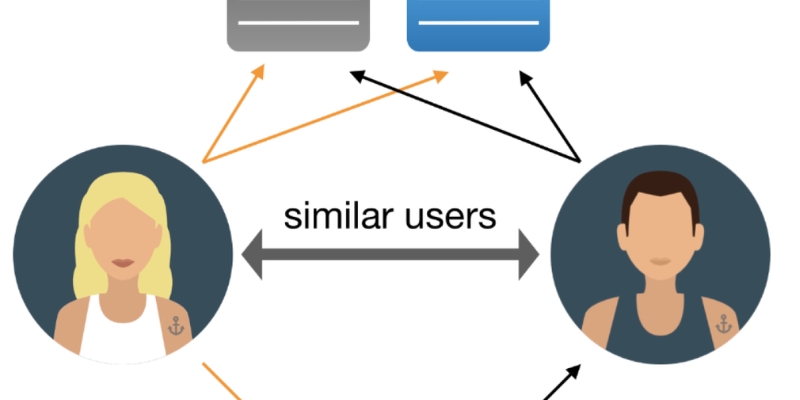
Collaborative filtering
Content-based filtering
Instead of looking at other customers, this approach focuses on the attributes of products themselves. By analyzing item characteristics (such as brand, color, or specifications) alongside a shopper’s past activity, it creates “If you liked this, you might also like that” recommendations tailored to one person’s taste.
Hybrid models
Hybrid engines combine both approaches to provide more accurate personalized product recommendations. They use collaborative data from similar customers and content-based insights from individual behavior, offering the best of both worlds. Brands like Netflix and Amazon employ these hybrid systems to maximize relevance and precision.
Integrating personalized product recommendations is not just about showing more products - it’s about guiding shoppers through a tailored journey that feels intuitive and seamless. The key to maximizing the benefit is to place recommendations in the right touchpoints. Here’s how:
Homepage
The homepage is the first impression customers get when visiting your ecommerce website, and it sets the tone for their entire journey. By integrating personalized product recommendations here, you can make every visitor feel like the store is tailored to them from the start. Rather than showing the same products to everyone, the homepage can highlight items based on browsing history, purchase behavior, or preferences.
Search results pages
Search is often a sign of clear customer intent, but shoppers do not always know exactly what they want. By incorporating personalized product recommendations into search results pages, you can guide them toward products that match their query as well as their past preferences. Instead of a flat, one-size-fits-all search experience, the results become dynamic and customer-centric.
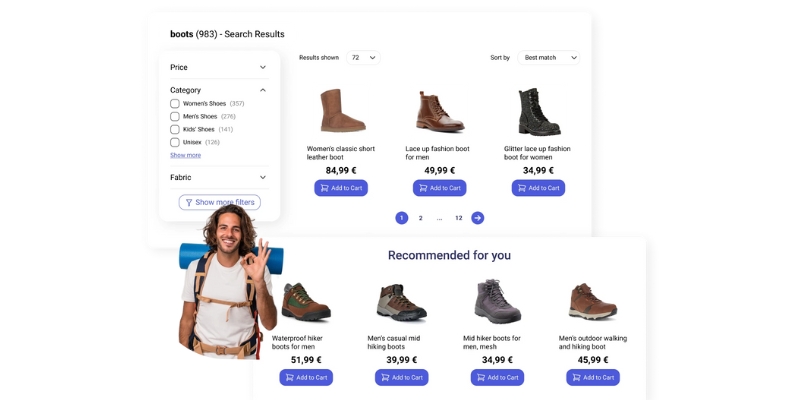
Search results pages
Category pages
When customers arrive at category pages, they are usually exploring a product type without a specific item in mind. Large catalogs can be overwhelming, making it difficult for shoppers to navigate. Personalized product recommendations here streamline this process by surfacing products that are most relevant to each individual. These can be items they previously showed interest in, trending products, or selections based on customer segments with similar behavior.
Product detail pages
Once a customer reaches a product detail page, personalization becomes even more valuable. At this stage, you already know what they are considering, which allows you to suggest complementary or alternative products with precision. Personalized product recommendations here can include similar items, accessories that enhance the main product, or premium versions that provide more features.
Shopping cart
The shopping cart is a key moment in the buying journey because customers have already shown strong purchase intent. This makes it an ideal stage to introduce subtle, relevant recommendations. Personalized suggestions here can encourage shoppers to add complementary products or small-value items that complete their purchase. Because these recommendations are tied directly to what the customer has already chosen, they feel helpful rather than intrusive, increasing the likelihood of a higher order value.
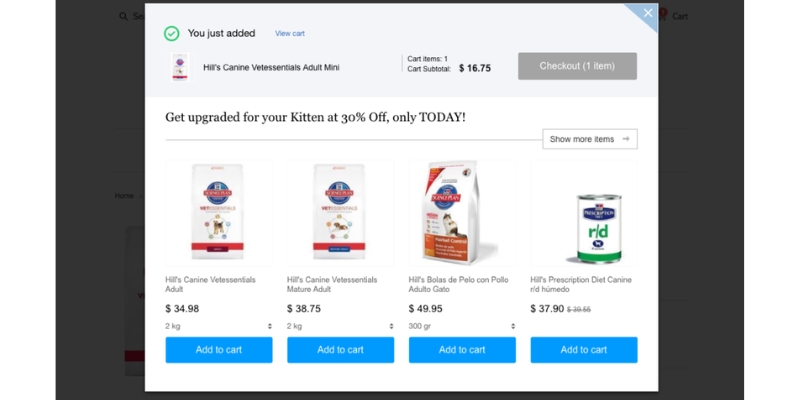
Shopping cart
Checkout page
Even at checkout, personalization can make a difference. Although this stage is primarily focused on confirming the purchase, relevant product recommendations can encourage last-minute add-ons. These could include quick bundles, frequently bought-together items, or time-sensitive offers that feel too good to miss. Customers are already emotionally invested in completing the transaction, so carefully placed personalized product recommendations can create additional value without causing friction.
Also read: AI For Checkout Optimization: A Guide For Ecommerce Businesses
Personalized product recommendations come in all shapes and sizes. Understanding what types there are and how they work is crucial for an effective strategy. Let’s have a closer look at each type of personalized product recommendations in practice.
Top-seller recommendations
Shoppers often look for cues on what’s popular. Top-seller recommendations highlight your best-performing products, helping new customers quickly discover items that others already love. This approach draws on the Pareto 80/20 rule: typically, 20% of your products generate 80% of your sales. Showcasing these high-performing items builds trust and speeds up the path to purchase.
For example, on Ikea’s category pages, visitors find a “Recommended for you” section that highlights best sellers. Seeing that other shoppers have already chosen these products gives customers extra confidence to explore further.
Rating-based recommendations
Nothing reassures potential buyers more than strong reviews and high ratings. Rating-based recommendations highlight products backed by social proof, making them appear more trustworthy.
These can be strategically placed on:
Cross-sell recommendations
Cross-selling personalized product recommendations offer complementary products to enhance the original purchase - like suggesting headphones when a shopper buys a smartphone. This mirrors the role of an attentive salesperson who knows how to complete the look or bundle.
Ways to use cross-sell strategies:
Customer data-driven recommendations
AI-powered algorithms can analyze browsing history, purchase patterns, and real-time interactions to serve data-driven product suggestions. AI systems continuously learn and predict customer behavior to provide highly personalized product recommendations while making sure they stay relevant as customer behavior evolves.
Amazon is a pioneer here. Its sections like “Pick up where you left off” or “Buy again” are powered by data-driven insights, keeping shoppers engaged at every click.
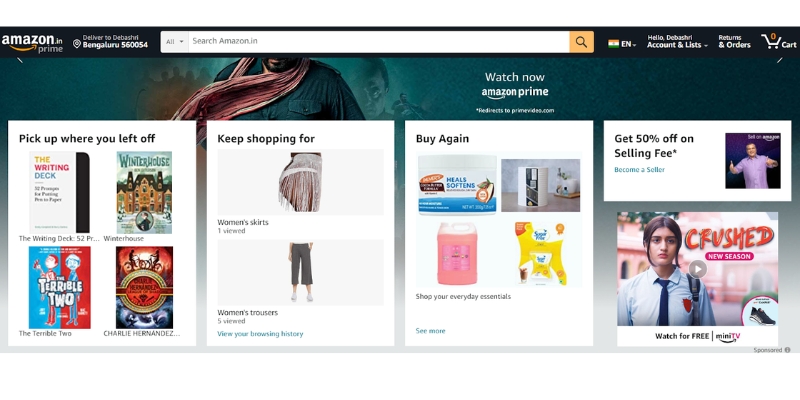
Customer data-driven recommendations
Remarketing recommendations
Not every shopper buys on the first visit. Personalized remarketing recommendations re-engage potential customers across different channels, reminding them of what they’ve left behind or suggesting similar alternatives.
Personalized email marketing recommendations
Email remains a powerful channel for personalized product recommendations. Campaigns can leverage customer behavior (e.g., purchase history, most visited categories) or product data (e.g., popularity, reviews) to increase engagement. Personalized subject lines and in-email recommendations significantly lift open rates and click-through rates.
Personalized product recommendations don’t happen by chance - they rely on the right technology, thoughtful strategy, and continuous refinement. Below is a practical guide to help you start implementing them for your business.
Step 1: Find the right tool
The foundation of any recommendation strategy is the tool that powers it. Many ecommerce platforms such as Shopify, Magento, and WooCommerce already include built-in recommendation features. These are straightforward to set up, making them a solid entry point for businesses looking to experiment with personalization. However, built-in systems may have limitations in terms of flexibility and advanced features.
For brands seeking more robust capabilities, third-party solutions provide a wider range of options. These tools often offer deeper insights into customer behavior, advanced targeting features, A/B testing, and granular analytics. Some allow recommendations to appear in multiple formats, from on-page product carousels to dynamic popups, side messages, or embedded content. By carefully selecting a tool that aligns with your goals, you create a foundation that can grow and adapt as your personalization strategy matures.
Step 2: Decide on the type of recommendation
Not all recommendations serve the same purpose. The effectiveness of personalization often depends on where and how it appears across your ecommerce site. You need to identify the most impactful recommendation types for each stage of the shopping journey.
On product detail pages, recommendations can highlight complementary or similar items, driving cross-sells and upsells. On category pages, showing popular products, seasonal collections, or new arrivals can encourage exploration. The homepage can showcase recently viewed items or curated picks that reflect a shopper’s browsing history. By tailoring recommendation types to specific contexts, you ensure they feel natural, helpful, and strategically aligned with customer intent.
Step 3: Segment your audience
Personalization thrives on precision, and segmentation is the key to achieving it. Instead of treating all customers the same, you can divide audiences into groups based on demographics, browsing behavior, purchase history, or engagement level. For instance, one segment may consist of first-time visitors who need discovery-driven recommendations, while another may include loyal customers who respond better to personalized offers or premium upgrades.

Segment your audience
Step 4: Test and optimize
Implementing personalized product recommendations is never a set-and-forget strategy. To remain effective, it requires continuous testing and refinement. You should consistently analyze performance metrics, run A/B tests on different formats or placements, and experiment with messaging styles to determine what resonates best with customers.
Optimization is about finding the balance between relevance and revenue. If recommendations feel overly generic, they risk being ignored; if they’re too aggressive, they may disrupt the shopping experience. By making optimization a core part of your strategy, you can adapt to changing customer behavior, market trends, and product availability - ensuring your recommendations remain impactful over time.
Implementing personalized product recommendations effectively requires more than just the right tools - it’s about following proven practices that keep suggestions relevant, engaging, and impactful. The best practices to bear in mind include:
Analyze the right behaviors
A recommendation engine is only as good as the data it learns from. Go beyond simple clicks and purchases to understand the “why” behind buying decisions. Consider factors like style preferences, brand loyalty, sustainability values, or purchase frequency. By focusing on meaningful behaviors, you can deliver recommendations that feel authentic and resonate with each customer’s intent.
Add recommendations beyond the storefront
Don’t limit personalized product recommendations to product pages. Integrate them into email campaigns, abandoned cart reminders, push notifications, and even error pages like 404 redirects. By showing recommendations in unexpected places, you create more touchpoints that re-engage customers and guide them back into the buying journey.
Feature the right number of recommendations
Balance is key. Overloading pages with too many suggestions risks overwhelming users, while too few can limit sales opportunities. A “quality over quantity” approach - showcasing a carefully curated selection at strategic moments - ensures customers view recommendations as helpful rather than distracting.
Use social proof to build trust
Customers often look for reassurance before making a purchase. Adding badges such as “Best Seller” or “Top Pick,” showing real-time purchase activity, or highlighting product reviews can make personalized product recommendations more persuasive. Social proof not only validates the suggested products but also encourages faster decision-making.
Ensure consistency across channels and devices
Customers expect a seamless, personalized shopping experience whether they interact with your brand via desktop, mobile, app, or email. Personalized product recommendations should remain consistent and optimized across all channels. Mobile-friendliness, in particular, is critical, as a growing share of ecommerce transactions now happens on smaller screens.
Test and optimize continuously
No strategy works perfectly from the start. A/B testing allows you to identify which types of recommendations work best in different contexts - for example, cross-sell boxes on product pages versus trending products on the homepage. Treat your recommendation engine as a living system that requires regular monitoring, experimentation, and refinement.
Personalized product recommendations are no longer a “nice-to-have” feature - they’re a business imperative. From boosting conversions and average order value to fostering loyalty and retention, the right recommendations transform casual browsers into repeat buyers.
At Sky Solution, we help ecommerce businesses harness the power of AI-driven personalization with solutions tailored to your unique goals. Whether you want to increase sales, optimize product discovery, or streamline customer journeys, our ecommerce solutions are built to deliver measurable growth.
Ready to unlock the full potential of personalization? Partner with Sky Solution today and turn every interaction into a revenue-driving opportunity. Contact us now for a free consultation!